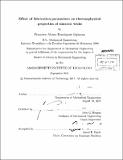Effect of fabrication parameters on thermophysical properties of sintered wicks
Author(s)
Domínguez Espinosa, Francisco Alonso
DownloadFull printable version (11.57Mb)
Other Contributors
Massachusetts Institute of Technology. Dept. of Mechanical Engineering.
Advisor
John G. Brisson.
Terms of use
Metadata
Show full item recordAbstract
Porous wicks for use in a loop heat pipe were sintered from copper and Monel powder. These wicks were characterized in terms of their shrinkage, porosity, thermal conductivity, liquid permeability and maximum capillary pressure. The effect of fabrication parameters (particle size and sintering conditions) on these properties was studied. Shrinkage was found to increase with increasing sintering time and temperature. Porosity followed the opposite trend. For a given sintering temperature, thermal conductivity of the samples was found to increase as the sintering time increased. Permeability and capillary pressure were found to be independent of the sintering time as long as the wick stayed bonded to the walls of its container. In addition to measuring the properties of the wicks, a model for predicting their thermal conductivity was developed. First, the so-called 'two-sphere model' is used to relate the sintering conditions to the size of the connections between particles (referred as 'necks'). Then, a finite element simulation was used to determine the thermal resistance of diverse unit cells as a function of the neck size between the particles. Finally a MATLAB simulation program was written to generate a random 3D resistor network as means to model the multiple connections between spheres in a wick. The MATLAB code was used to calculate the effective thermal conductivity of the wick. Comparison of the model predictions with the experimental data showed good agreement.
Description
Thesis (S.M.)--Massachusetts Institute of Technology, Dept. of Mechanical Engineering, 2011. Cataloged from PDF version of thesis. Includes bibliographical references (p. 134-140).
Date issued
2011Department
Massachusetts Institute of Technology. Department of Mechanical EngineeringPublisher
Massachusetts Institute of Technology
Keywords
Mechanical Engineering.